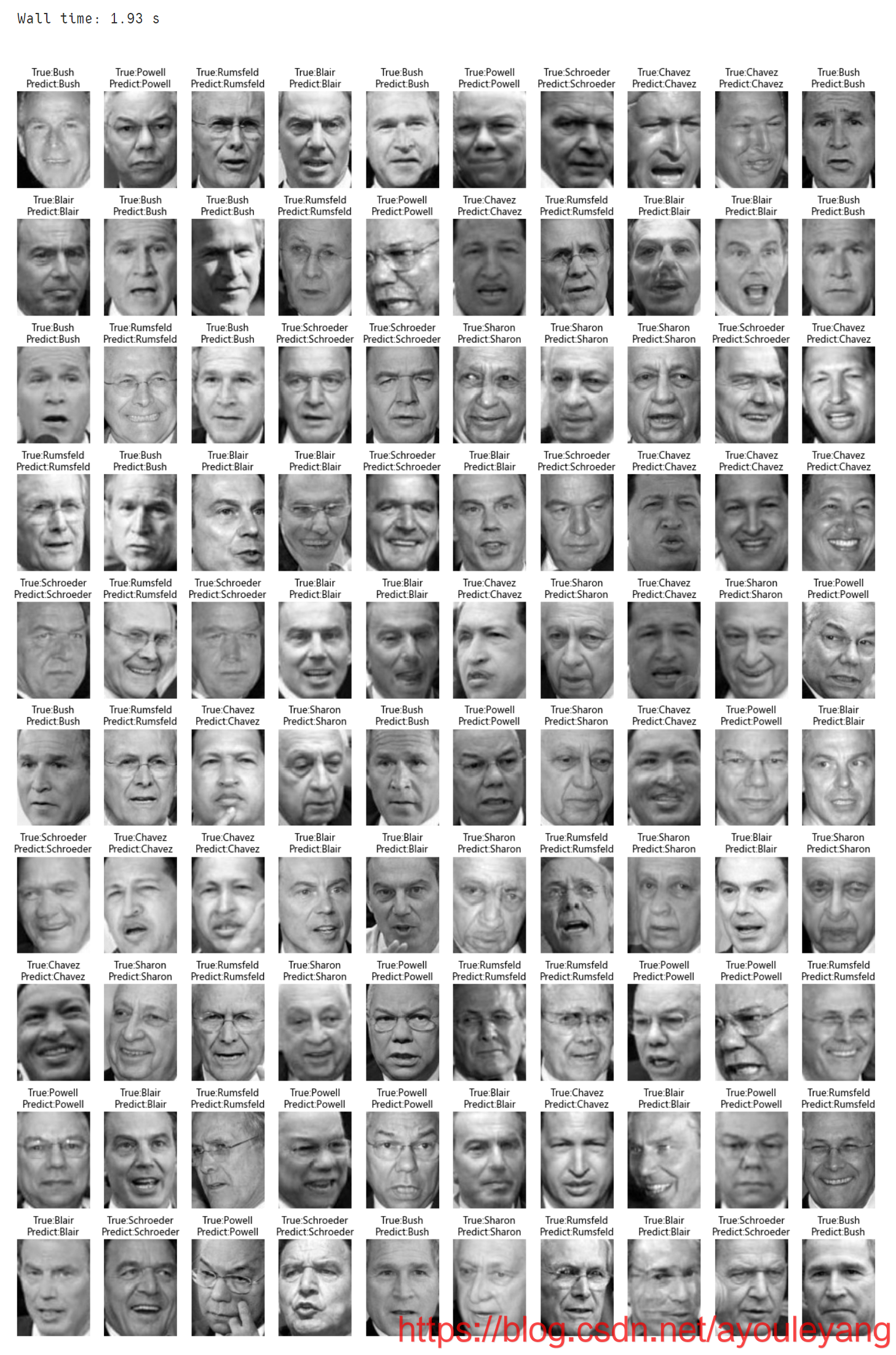操作平台: windows10, python37, jupyter
任务目标: 使用SVC算法,识别人脸,姓名
![]()
![]() 1、导入图片数据
1、导入图片数据
import numpy as np
import matplotlib.pyplot as plt
%matplotlib inline
import sklearn.datasets as datasets
from sklearn.svm import SVC
#它加载图片的位置在计算机用户目录下scikit_learn_data中,如果不存在它会自动从网上下载
faces = datasets.fetch_lfw_people(min_faces_per_person=70,resize=1) #只加载大于70张图片的数据,resize原尺寸
faces
{'data': array([[254. , 254. , 254.66667 , ..., 87.666664, 86.333336,
86.333336],
[ 42. , 33. , 32.333332, ..., 122. , 148.33333 ,
185.33333 ],
[ 94. , 72. , 74. , ..., 182.66667 , 183. ,
182.33333 ],
...,
[ 85. , 85.666664, 85.333336, ..., 44. , 36.333332,
30.333334],
[ 49.666668, 49.666668, 48.333332, ..., 178.33333 , 166.66667 ,
126.333336],
[ 31.333334, 33.333332, 26.666666, ..., 48.333332, 63. ,
99. ]], dtype=float32),
'images': array([[[254. , 254. , 254.66667 , ..., 42. ,
38. , 39. ],
[254. , 254.33333 , 254. , ..., 43.333332,
38. , 39. ],
[254.66667 , 254.33333 , 253.33333 , ..., 44. ,
39. , 39. ],
...,
[ 44. , 41.333332, 42.333332, ..., 38.333332,
50.666668, 60.666668],
[ 47. , 45.333332, 51.333332, ..., 44.666668,
61.666668, 84.666664],
[ 46. , 45.333332, 47.333332, ..., 48.333332,
63. , 99. ]]], dtype=float32),
'target': array([5, 6, 3, ..., 5, 3, 5], dtype=int64),
'target_names': array(['Ariel Sharon', 'Colin Powell', 'Donald Rumsfeld', 'George W Bush',
'Gerhard Schroeder', 'Hugo Chavez', 'Tony Blair'], dtype='<U17'),
'DESCR': ".. _labeled_faces_in_the_wild_dataset:\ ...结果分析: 我们导入的数据中有五个参数,分别为data, images, target, target_names, DESCR。
取出目标值:
X = faces['data']
y = faces['target']
names = faces.target_names
image = faces['images']
image.shape
(1288, 125, 94)1
![]()
![]() 2、随机查看图片
2、随机查看图片
index = np.random.randint(1288,size = 1)[0]
plt.imshow(image[index],cmap = plt.cm.gray) #绘制图片
print(y[index]) #文件夹
names[y[index]] #文件夹名称,也就是人的名字
3
'George W Bush'

![]()
![]() 3、建模评估
3、建模评估
%%time
from sklearn.model_selection import train_test_split
X_train,X_test,y_train,y_test = train_test_split(X,y,test_size = 0.2)
svc = SVC(kernel='rbf') #高斯分布
svc.fit(X_train,y_train)
print(svc.score(X_test,y_test))
0.7906976744186046
Wall time: 32.1 s
结果分析: 该方法训练测试数据大约耗时32秒,用时较长,准确率约80%。
![]()
![]() 4、PCA数据处理
4、PCA数据处理
![]()
![]() 4.1、数据脱敏处理
4.1、数据脱敏处理
from sklearn.decomposition import PCA
# 主成分分析
# Principal component analysis (PCA)
# whiten = True 白化,归一化
pca = PCA(n_components=0.9,whiten = True) #降低9倍
# 代表原来的数据,经过矩阵运算,结果属性看不懂(属性,没有实际的物理意义),脱敏数据
X_pca = pca.fit_transform(X)
X_pca.shape
(1288, 116)1
结果分析: 经过脱敏处理后,它的数据量下降,主要是因为舍弃了一些没有意义的值,但是它的结果属性很是看不懂的,没有物理意义。
![]()
![]() 4.2、建模评估
4.2、建模评估
%%time
X_train, X_test, y_train, y_test = train_test_split(X_pca,y,test_size = 0.2)
svc = SVC()
svc.fit(X_train, y_train)
print(svc.score(X_test,y_test))
0.7829457364341085
Wall time: 405 ms
结果分析: 它的精确率没有发生明显的变化,但是使用的时间却在明显的提升。
![]()
![]() 5、过采样技术处理
5、过采样技术处理
![]()
![]() 5.1、查看原始数据
5.1、查看原始数据
for i in range(7):
print(names[i],(y == i).sum())
Ariel Sharon 77
Colin Powell 236
Donald Rumsfeld 121
George W Bush 530
Gerhard Schroeder 109
Hugo Chavez 71
Tony Blair 144
结果分析: 我们用来学习的数据一共有7个人,少的有71张图片,多的有530张图片,接下来将使用过采量技术,把所有数据都填充到530张人脸图片。
![]()
![]() 5.2、过采量
5.2、过采量
from imblearn.over_sampling import SMOTE
smote = SMOTE()
X2,y2 = smote.fit_resample(X,y) #重新采样
#查看采样结果
for i in range(7):
print(names[i],(y2 == i).sum())
Ariel Sharon 530
Colin Powell 530
Donald Rumsfeld 530
George W Bush 530
Gerhard Schroeder 530
Hugo Chavez 530
Tony Blair 530
结果分析: 现在所有人的脸部照片都是530张了。
![]()
![]() 5.3、建模评估
5.3、建模评估
%%time
X_train,X_test,y_train,y_test = train_test_split(X2_pca,y2,test_size = 0.2)
svc = SVC()
svc.fit(X_train,y_train)
print(svc.score(X_test,y_test))
0.9824797843665768
Wall time: 1.65 s
结果分析: 现在的准确率高达98%,并且只需要约1.6秒钟,已经相当不错了。
![]()
![]() 5.4、批量展示预测图片
5.4、批量展示预测图片
%%time
#切分训练集和测试集
face_train,face_test,X_train,X_test,y_train,y_test = train_test_split(X2,X2_pca,y2,test_size = 0.2)
y_ = svc.predict(X_test) #预测
plt.figure(figsize=(10*2,10*3)) #设置画布
for i in range(100):
ax = plt.subplot(10,10,i + 1)
face = face_test[i].reshape(125,94) #image.shape = (1288, 125, 94)
ax.imshow(face,cmap = 'gray') #展示图片
ax.axis('off') #隐藏x,y轴
t = names[y_test[i]].split(' ')[-1] #真实名称
p = names[y_[i]].split(' ')[-1] # 预测出来的名称
ax.set_title('True:%s\nPredict:%s'%(t,p))
作者:阿优乐扬
链接:https://blog.csdn.net/ayouleyang/article/details/105045254
来源:CSDN
著作权归作者所有,转载请联系作者获得授权,切勿私自转载。
![]()
![]() 1、导入图片数据
1、导入图片数据![]()
![]() 2、随机查看图片
2、随机查看图片
![]()
![]() 3、建模评估
3、建模评估![]()
![]() 4、PCA数据处理
4、PCA数据处理![]()
![]() 4.1、数据脱敏处理
4.1、数据脱敏处理![]()
![]() 4.2、建模评估
4.2、建模评估![]()
![]() 5、过采样技术处理
5、过采样技术处理![]()
![]() 5.1、查看原始数据
5.1、查看原始数据![]()
![]() 5.2、过采量
5.2、过采量![]()
![]() 5.3、建模评估
5.3、建模评估![]()
![]() 5.4、批量展示预测图片
5.4、批量展示预测图片
